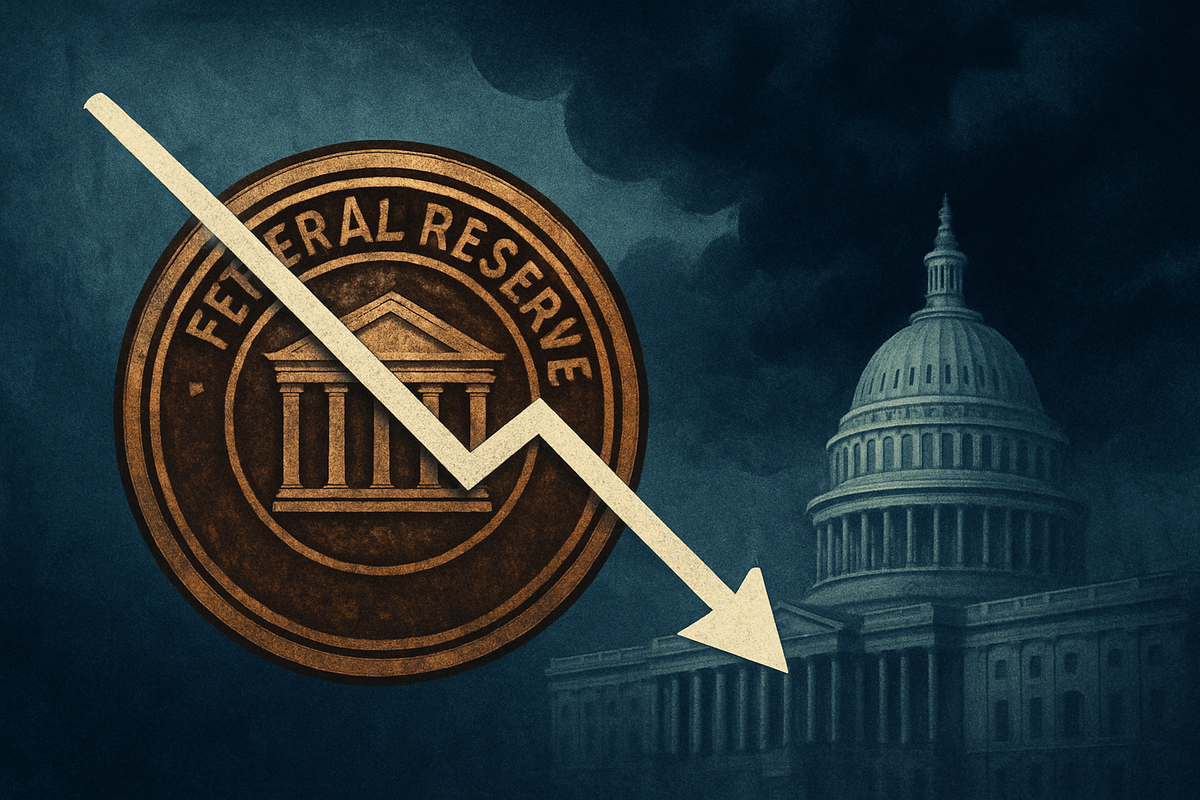
Washington D.C. finds itself at a critical juncture as the Federal Reserve, on October 29, 2025, announced a significant cut to its benchmark interest rate, bringing it to its lowest level in three years. This crucial monetary policy adjustment comes amidst an ongoing federal government shutdown, creating a complex and uncertain economic environment. The simultaneous events present a challenging scenario for policymakers, businesses, and consumers alike, as the central bank attempts to stimulate a weakening economy while operating with limited visibility due to a crucial data blackout.
The rate cut, a 25-basis-point reduction, sets the federal funds rate to a target range of 3.75% to 4.00%. This marks the second consecutive rate cut this year and signals the Federal Reserve's growing concern over a decelerating labor market and heightened economic uncertainty. However, the economic stimulus from lower rates is immediately counteracted by the government shutdown, which is now entering its fourth week, halting essential government services and furloughing hundreds of thousands of federal workers.
Detailed Coverage: Navigating the Dual Crisis
The Federal Reserve's decision to cut interest rates to a three-year low is a direct response to a mounting body of evidence suggesting a cooling U.S. economy, particularly in the labor market. While inflation, at around 3% annually, remains above the Fed’s 2% target, the central bank appears to be prioritizing the risks of a significant downturn. The path to this decision began in early 2025, following a period of aggressive rate hikes in 2022 and 2023 aimed at curbing surging inflation. By summer 2025, economic data, though mixed, increasingly pointed to a softening labor market, with monthly payroll gains slowing and the unemployment rate ticking upwards.
The Federal Open Market Committee (FOMC), the primary body responsible for setting U.S. monetary policy, initiated its first rate cut in September 2025. This was followed by the current October cut, bringing the federal funds rate to its lowest point since 2022. A critical complicating factor has been the federal government shutdown, which commenced on October 1. This legislative deadlock has not only furloughed federal employees but has also suspended the release of vital economic data, including the monthly jobs report and inflation figures. This "data drought" has forced the Fed to make critical policy decisions with limited visibility, relying more heavily on private-sector indicators and qualitative assessments. Federal Reserve Chair Jerome Powell acknowledged the "strongly differing views" within the committee regarding the path forward, emphasizing that policy is not on a "pre-set course."
Key players in this unfolding drama include the Federal Reserve Board & FOMC, led by Chair Powell, who are tasked with steering monetary policy. Their decision to cut rates reflects a proactive stance against a weakening labor market, despite the challenges posed by the data blackout. Congress bears responsibility for the government shutdown, having failed to pass appropriations bills, leading to the suspension of non-essential government services. This political impasse, while not directly controlling monetary policy, significantly complicates the Fed's task by obscuring the economic picture. The President is central to ending the shutdown by signing appropriations bills and has also exerted political pressure on the Fed for lower rates, adding another layer of complexity to the economic environment.
Initial reactions from financial markets have been mixed. The Stock Market saw slight declines in the S&P 500 and Dow Jones Industrial Average shortly after the announcement, reflecting a tempering of enthusiasm due to the government shutdown's uncertainty. However, the Nasdaq, buoyed by specific tech sector strength (e.g., Nvidia (NASDAQ: NVDA) reaching a $5 trillion market cap), managed to erase earlier losses. The Bond Market reacted more predictably, with yields on U.S. Treasuries falling, driving up bond prices. The U.S. Dollar (DXY) initially churned before seeing slight upside, as nuanced comments from Chair Powell about future cuts not being a "foregone conclusion" created a perception of policy resistance.
Specific industries are experiencing varied impacts. The Banking Industry anticipates increased activity from lower borrowing costs but faces operational challenges from delayed federal permits due to the shutdown. The Housing Market welcomes the rate cut, expecting lower mortgage rates to boost affordability and demand, though the shutdown could delay federal loan processing. Government-Dependent Sectors, such as defense and federal contractors, are significantly impacted by the shutdown, facing halted projects and delayed payments. The Travel and Tourism sector has also experienced disruptions due to furloughed federal workers, particularly at airports.
Companies on the Brink: Winners and Losers
The dual forces of lower interest rates and a government shutdown create a bifurcated landscape for public companies, where some sectors may find opportunities while others face significant headwinds.
Sectors and Companies Likely to Win: Lower interest rates generally stimulate economic activity by making borrowing cheaper. This is a boon for Technology companies, especially those not heavily reliant on direct government contracts. Cheaper capital fuels innovation, research and development, and expansion, leading to higher valuations and increased investment. Companies with strong balance sheets can leverage lower debt costs for strategic acquisitions and product development. In the Real Estate sector, lower mortgage rates improve affordability and demand, benefiting homebuyers and developers. Well-capitalized investors and developers who can navigate the temporary transactional freeze caused by the shutdown might find opportunities to acquire properties at favorable prices, anticipating a rebound once the shutdown resolves. The Consumer Discretionary sector could also see a boost from increased consumer spending once the shutdown concludes, as lower interest rates free up disposable income. Companies with a broad consumer base and less geographic concentration near federal hubs are better positioned to benefit.
Sectors and Companies Likely to Lose: Conversely, the government shutdown presents immediate and severe challenges for certain sectors. Government Contractors are arguably the biggest losers. Companies like Lockheed Martin (NYSE: LMT) or Raytheon Technologies (NYSE: RTX), while often having long-term contracts, face halted projects, delayed payments, and potential layoffs due to the lack of government oversight and funding. The operational disruptions and cash flow problems can be substantial, particularly for small and mid-sized contractors. The Banking Industry, while potentially benefiting from increased loan demand, faces pressure on net interest margins from lower rates and significant operational delays due to the shutdown. Delays in federal loan programs (e.g., Small Business Administration (SBA), FHA, VA) directly impact their lending activities and revenue. The Real Estate sector, particularly short-term transactions and those relying on federally-backed loans (like FHA, VA, and USDA mortgages), will suffer from processing delays and the potential lapse of programs like the National Flood Insurance Program (NFIP). Companies operating in areas with a high concentration of federal employees will also likely see a sharp drop in demand.
Wider Significance: A Precedent for Instability?
The Federal Reserve's decision to cut interest rates to a three-year low amidst an ongoing government shutdown carries profound wider significance, fitting into broader economic trends and potentially setting new precedents for navigating instability.
This monetary easing, driven by a weakening labor market despite persistent inflation, highlights the delicate balancing act the Fed is forced to perform. The government shutdown, however, introduces a substantial and unpredictable fiscal drag. The Congressional Budget Office (CBO) estimates a prolonged shutdown could reduce annualized real GDP growth by 1.0 to 2.0 percentage points in Q4 2025, resulting in a permanent loss to the economy of billions of dollars. This economic contraction, combined with the Fed's "flying blind" scenario due to the data blackout, elevates the risk of misjudging the economy's true health and implementing suboptimal policy. This situation underscores a broader trend of increased political risk directly impacting economic policy.
The ripple effects extend globally. Lower U.S. interest rates typically weaken the U.S. dollar, making American exports more competitive and potentially easing the debt burden for emerging market economies with dollar-denominated obligations. This could encourage other central banks, such as the European Central Bank, to adopt more accommodative monetary policies. However, the U.S. government shutdown, if prolonged, could trigger global risk aversion, leading to capital outflows from emerging markets despite the Fed's easing. Existing geopolitical risks and trade tensions further complicate these international dynamics.
For the financial sector, regulatory and policy implications are significant. A government shutdown severely impacts agencies like the Securities and Exchange Commission (SEC) and the Commodity Futures Trading Commission (CFTC), leading to a suspension of many regulatory functions, including processing filings and routine examinations. This can create a backlog and raise concerns about diminished regulatory oversight. While FDIC-insured banks remain operational, government-backed loans face processing delays, offsetting some benefits of lower rates for borrowers. Historically, the Fed has had to rely on private-sector data during past shutdowns (e.g., 2018-2019), demonstrating its operational independence but highlighting the vulnerability of data-driven policy in times of fiscal paralysis. This current event emphasizes the critical importance of the Federal Reserve's independent funding structure, which allows it to continue monetary policy even when other government functions cease.
What Comes Next: Navigating the Unknown
The future outlook for the U.S. economy and financial markets is characterized by significant short-term disruptions and the need for strategic adaptations.
In the short-term, the economic contraction from the government shutdown will likely persist, further dampening consumer and business confidence. The Fed's rate cuts, while aiming to stimulate, will struggle against this fiscal headwind, creating conflicting signals. Market volatility is expected to continue as investors grapple with political uncertainty and the absence of crucial economic data. For businesses, robust cash flow management and diversification of revenue streams away from government dependency will be paramount. Companies will need to increasingly rely on alternative data sources to inform their decisions in the "data blackout" environment.
The long-term possibilities hinge on the duration and resolution of the government shutdown. A quick resolution might limit permanent economic damage, allowing the Fed's rate cuts to gradually stimulate growth. However, a prolonged shutdown risks more lasting economic scars and could challenge the Fed's effectiveness in guiding the economy, especially with incomplete data. Paradoxically, while lower rates aim to stimulate, they could also increase the cost of servicing the burgeoning national debt over time. Emerging markets might see opportunities for capital inflows due to a weaker dollar, but this could be overshadowed by global risk aversion if the U.S. instability deepens.
Various scenarios could unfold for the U.S. economy. A "Muddle Through" scenario suggests a quick shutdown resolution, allowing the Fed's cuts to prevent a deeper downturn. A "Stagflation-Lite" scenario could emerge if the shutdown persists and inflation remains elevated, leading to slow growth coupled with persistent price increases. The most severe outcome is a "Recessionary Dive" if a prolonged shutdown, coupled with ineffective rate cuts and a loss of confidence, triggers a significant economic contraction. For financial markets, short-term choppiness could give way to resilience if the shutdown resolves, driven by lower borrowing costs. However, a prolonged crisis could lead to increased risk aversion, a flight to safe-haven assets, and even a tightening of credit markets despite the Fed's easing.
Comprehensive Wrap-Up: A Test of Resilience
The Federal Reserve's decision to cut interest rates to their lowest level in three years, made against the backdrop of an ongoing government shutdown, marks a pivotal moment for the U.S. economy. This action underscores the central bank's deep concern over a weakening labor market, even as persistent inflation continues to be a challenge. The concurrent government shutdown has severely compromised the Fed's ability to make data-driven decisions, forcing it to navigate the economy with "limited visibility."
Key Takeaways from this unprecedented situation include the Fed's difficult balancing act between employment and price stability, the critical challenge to data-dependent policymaking, and the clear prioritization of labor market support. The internal disagreements within the FOMC highlight the complexity and uncertainty surrounding the current economic outlook.
Moving forward, the market's trajectory will be heavily influenced by the resolution of the government shutdown. While lower rates typically provide a short-term boost to equities and can lead to dollar weakness, the economic drag and uncertainty from the shutdown could temper these effects. Investors should anticipate continued volatility. The significance of this event lies in its unprecedented combination of monetary easing during active government dysfunction, which challenges the very foundation of data-driven economic management and potentially erodes confidence in governmental stability.
For investors, the coming months demand caution and a diversified approach. Closely monitor developments regarding the government shutdown, as its duration and resolution will be primary market drivers. Pay meticulous attention to any available inflation and labor market data, even from private sources, for clues on the Fed's future path. Be mindful of sectoral impacts, as different industries will react unevenly to the combined forces of lower rates and government disruption. Scrutinize corporate earnings and forward-looking guidance for insights into business health. Consider defensive positions in portfolios to mitigate risks during this uncertain period. Finally, be prepared for further potential Fed actions, as the central bank has emphasized that its policy is not on a "pre-set course" and will remain data-dependent, despite the current "cracked windshield" scenario.
This content is intended for informational purposes only and is not financial advice



